Time-tested Traditions at Camp
The Unit System
Under our Unit System campers are grouped according to grade level, and they participate in the majority of their activities as a unit. This structure promotes an intensive group living experience. While campers try new activities or improve their skills in familiar areas they are also learning to live together. A good portion of our work is focused on giving support and guidance to our campers through the conflicts and issues that naturally arise out of such an environment. This requires compassionate and competent leadership.
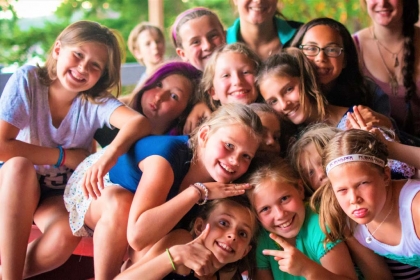 While not unusual on the east coast, a 4-week session is considered a large commitment by many families. For us it supports our focus on group living and community. Group development follows a natural progression which can only be fully realized with an extended-stay program.
While not unusual on the east coast, a 4-week session is considered a large commitment by many families. For us it supports our focus on group living and community. Group development follows a natural progression which can only be fully realized with an extended-stay program.
Over the years, the unit system has morphed and changed to adapt to the demands of our camper base. In 1935, the camp was founded with three groups for boys, Juniors, Middles, and Seniors, but within two years campers were either Cavemen, Indians, Islanders, or Mountaineers. The first female campers were Weavers, Archers, and Voyageurs. Over the past eight decades the unit system has grown to include twelve units, with unit names changing as our community works to be more inclusive and aware: Archers, Explorers, Mariners, Rangers, Vagabonds, Pioneers, Voyageurs, Foresters, Wayfarers, Islanders, Troubadours, and Mountaineers. While the names may have changed, our goal is the same: to provide a group living experience that guides and supports the individual to self-discovery and growth.
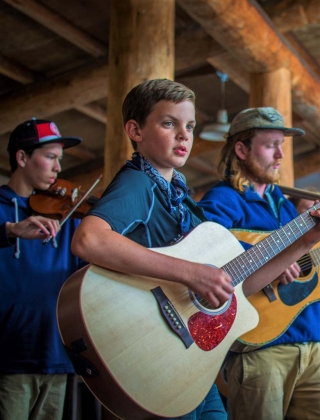
Music
Music is an important part of everyday life at Nor’wester. Folk songs and ballads from many countries, reflecting different times and ways of life, are sung after meals in the dining hall, at campfires, in the shower, and on the trails. Our Camp Songbook is likely the best link between generations of campers: songs sung in 1935 are still heard in the Lodge and around the campfire today. For many, learning songs at camp has sparked an interest in music as a life-long hobby.
In addition to singing together after meals, music is featured several times throughout each session in an effort to build community. Folk dances take place in the lodge a few nights each week, songs of a reflective nature are sung at Chapel during community meetings, campers and staff lead singing around unit fire circles, and our weekly Musicales are a very powerful forum for seasoned- and first time-performers to share their talents. The Golden Day is Dying has been sung after every single Campfire since 1935.
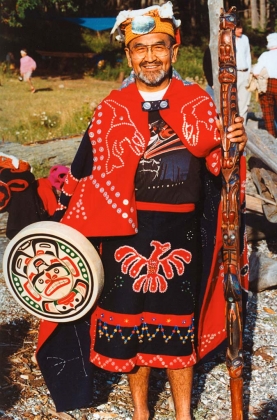 Cultural Community Connections Activities
Cultural Community Connections Activities
Located on a site with clear and longstanding evidence of native occupation, we strive to acknowledge that the property is located on traditional Salish land (see Property Location & Region information). Nor’wester also has a unique tradition of Northwest Coastal art and culture.
This tradition, inherited from the Henderson Camps, is based on a relationship that started in the 1950s between members of the camp community and members of the Kwagiutl community from Tsax̱is (known as Fort Rupert). This relationship is reflected in the camp’s totems, canoes, and a spectacular Kwakwaka’wakw-style Bighouse. It influences much of the artwork produced at camp, and is the basis for the gift exchange which takes place at each season’s end. All campers and staff learn about Northwest Coastal tribes, including the Kwagiutl, other groups of the Kwakwaka’wakw Nation, and increasingly the Coast Salish groups that inhabit the region where camp is located.
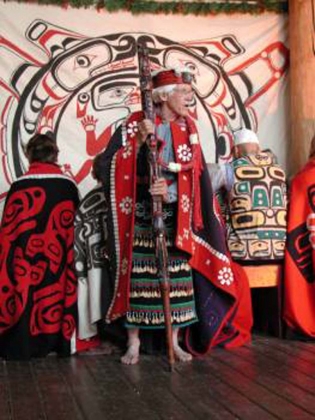
Central to this tradition is the community’s continued relationships with First Nations campers and alumni over the years. Since the 1950s, First Nations and Native American campers have attended camp sessions, gaining from the Nor’wester experience as young adults, and many have returned to camp in a staff or visiting educator capacity. As a result, camp’s Cultural Community Connections Program has thrived.
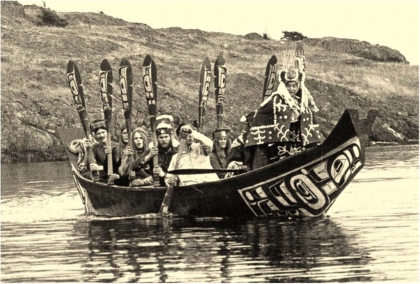 Focusing on educational experiences for campers in the realm of indigenous culture, art, traditions, and history, the program has been a highlight for many generations of campers over the years, and is often named by alumni as the spark for a life-long interest. Units participate in traditional games, enjoy stories and teachings, assist in creating art and regalia, and learn about songs and dances. Although the focus is often centered on Kwakwaka’wakw culture because of the relationship Camp has with members of the Kwagiutl community, art of several Northwest Coast styles can be found around the property, and Nor’wester continues to build relationships with indigenous educators and artists of many backgrounds through outreach and our Visiting Artist/Educator program. As we increase our collective understanding of the history and current experiences of coast Salish people in the region, and recognize that Nor’wester exists on coast Salish land, we strive to bring more understanding of the coast Salish people, language, and culture to our campers.
Focusing on educational experiences for campers in the realm of indigenous culture, art, traditions, and history, the program has been a highlight for many generations of campers over the years, and is often named by alumni as the spark for a life-long interest. Units participate in traditional games, enjoy stories and teachings, assist in creating art and regalia, and learn about songs and dances. Although the focus is often centered on Kwakwaka’wakw culture because of the relationship Camp has with members of the Kwagiutl community, art of several Northwest Coast styles can be found around the property, and Nor’wester continues to build relationships with indigenous educators and artists of many backgrounds through outreach and our Visiting Artist/Educator program. As we increase our collective understanding of the history and current experiences of coast Salish people in the region, and recognize that Nor’wester exists on coast Salish land, we strive to bring more understanding of the coast Salish people, language, and culture to our campers.
For information on our Indigenous Campership Award, please visit our Financial Aid Opportunities page, and scroll down.
Our entire community at Camp Nor’wester has the rare and beautiful opportunity to live in tipis and platform tents each summer. Tipis have been the living structure most associated with camp since its inception in 1935.
Why do we live in tipis?
- We love being close to nature, with the bare earth beneath our feet and the sun filtering through the canvas.
- Living in tipis together helps to promote engagement between campers and staff on a more intimate level, resulting in deepened friendships and heightened awareness regarding community living.
- The sturdy structure of a tipi and its conical shape withstand wind and rain yet allow air to move through, helping us immerse in nature with humble respect.
- We utilize our resources on camp land to make poles and have the ability to place tipis in precarious places that otherwise would not accommodate a living structure.
- We strive to live light on the land and we allow the property to go back to its natural state for nine months before setting up tipis once again. This cycle also allows for flexibility in placement, fluidity in programming and an honoring of the land.
We acknowledge, with full transparency, that tipi structures originated in the Great Plains region of the United Stated and Canada within the Plains Native Culture. Nor’wester does not have an authentic connection or tie to this culture, so we are currently in discussion about what it means for us to continue our tradition of living in tipis. We are striving to educate our community and choose to continue to move into the future with sensitivity, compassion and intention around all things we do.
We acknowledge that there is a fine line between cultural appreciation and appropriation. Our C5 Board Committee (Creating Cultural Competence in our Camp Community) and members of camp leadership are dedicated to continued conversation about this topic and seek to understand all voices in the community as well as societal and cultural observations from outside the community.
We acknowledge that Camp Nor’wester’s love of indigenous culture over the years has solidified tipis as part of our story and sense of place since 1935. This love and appreciation also means that we may need to let go of some things that have been a tradition in our community in order to stay consistent with our values, acting in the utmost integrity as we move into our sustainable future.
Lodging Structures at Nor'wester - Current Updates for Summer 2024
In the fall of 2021, the Nor'wester Board of Directors voted to transition away from tipis as the primary lodging structure used in our summer program. A small work group formed in 2020 to explore suitable alternatives to tipis for use on property. Please see our Fall 2022 Newsletter to read a message to the Nor'wester Community regarding our ongoing tipi transition.
In the summer of 2022, custom bell tents were used in three units after a small trial run the previous summer. We also tested out an air dome tent model in two different units. In the summer of 2023, two units used air dome tents, and two units used bell tents.
Trials for additional structure types will be arranged for near-future summers, as we decide on suitable structures to test.
Historical Overview: Celebrating 85 Years!
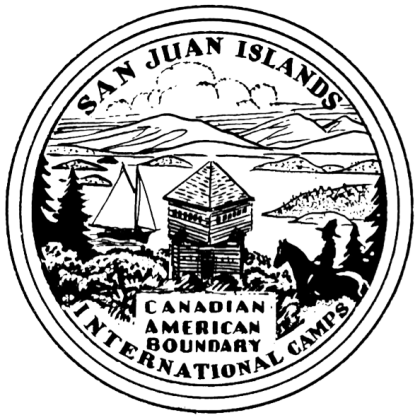 1935-1945: Westcott Bay, San Juan Island – Frank and Lucile Henderson
1935-1945: Westcott Bay, San Juan Island – Frank and Lucile Henderson
1935 – San Juan International Camps for Boys and Young Men was established by Frank C. Henderson (Tyee) on San Juan Island’s Westcott Bay, near Roche Harbor. Frank’s dream was to bring boys from the United States and Canada together for a stimulating camping experience, similar to those he had participated in through the Boy Scouts’ International Jamborees. Thirty-three boys enrolled the first year with stays ranging from 2 days to 9 weeks. Three of the campers were veterans of a trip to the Boy Scout Jamboree in Australia led by Tyee the previous winter. The boys lived in tipis and were grouped into three units: Juniors, Midders, and Seniors. Eight regular staff were assisted by a number of visiting volunteer staff.
1936 – Fifty-two boys were enrolled in two 5-week sessions. In the winter of ’36-’37, Frank opened the San Juan Ski Lodge in a rented building at Snoqualmie Pass. Ski lessons and lodging were offered for boys and girls.
1937 – Sixty-seven boys enrolled in four units: Cavemen, Indians, Islanders, and Mountaineers. A singing program was added, and a two-week adult camp was offered after the regular season.
1938 – Frank Henderson married Lucile Townsend (Rabbit), former director of Seattle Girl Scouts and Camp Robbinswold. The first Olympic Games were held. Twelve boys enrolled in a three-week session for diabetic campers.
1939 – The adult camp offered a week-long cruise to Princess Louisa Inlet.
1941 – Enrollment continued to increase, but with war looming and the inception of the draft, staffing was becoming more difficult. In January, the Hendersons moved their ski program to a lodge at Snoqualmie Pass purchased from Bush School.
1942 – Ten girls enrolled in the new North Star Camp for Girls. A Potlatch (without the Northwest Coast dances) was held.
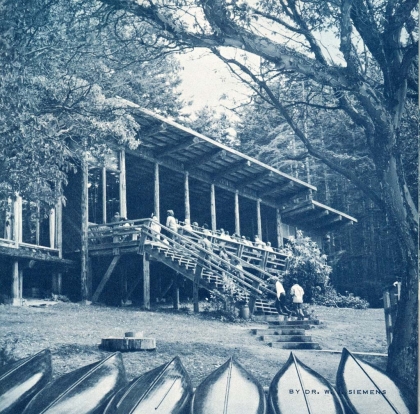 1943 – North Star was divided into Weavers, Archers, and Voyageurs. The Tarzan unit was added between the Cavemen and Indians.
1943 – North Star was divided into Weavers, Archers, and Voyageurs. The Tarzan unit was added between the Cavemen and Indians.
1944 – There were about 140 campers this year.
1945 – When the Hendersons learned their lease on Westcott Bay would not be extended, they began searching for a new campsite. 310 acres on Lopez Island’s Sperry Peninsula were purchased. Over the next twenty years the remaining 60 acres of the peninsula were acquired.
1946-1966: Sperry Peninsula, Lopez Island – Frank and Lucile Henderson
1946 – All removable buildings and equipment were barged from San Juan Island to Lopez. A new Lodge and Boys’ Shower House were built of lumber and stone from the property. The historic Kay House, circa 1876, site of Lopez’s first murder in 1882, was rebuilt as Trader Horn. An earthen dam was built at the head of the Great Meadow to enlarge the lake for the main water supply. Names were given to Chapel Rock, Cactus Rock, Hidden Corral, Poker Chip Bay, Madrona Plateau, Mossy Plateau, Sea Parrot Bluff, Octopus Cove, Agate Beach, and Tide Rocks.
1947 – The capture-the-flag course was laid out.
1951 – Flash, the first wooden Lightning class sailboat, was purchased.
1953 – A saltwater, solar-heated 30′ x 60′ pool was built below the Lodge. A fourth girls’ unit, the Vagabonds, was added between the Archers and Voyageurs. The length of the sessions was changed from 6 weeks and 3 weeks to 5 weeks and 3 weeks.
1954 – The Cooks’ Cabin was built. Although it was designed to house the cooks, its main use over the years has been for storage.
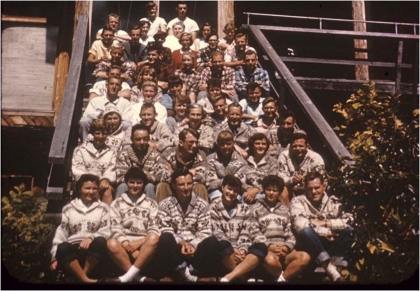 1955 – A Kwakwaka’wakw-style Bighouse (the Indian House) was built by staff and campers, and a Potlatch was held there for the first time.
1955 – A Kwakwaka’wakw-style Bighouse (the Indian House) was built by staff and campers, and a Potlatch was held there for the first time.
1956 – The Health Center was built. The sessions were changed to 4 weeks each.
1957 – Chief and Mrs. Mungo Martin, and other members of the Kwakwaka’wakw Tribe, attended the Potlatch for the first time.
1958 – Bill Holm carved the canoe Sisiutlamala. The winter of ’57-’58 was the last season for the Ski Camp at Snoqualmie Pass.
1960 – A new entrance gate was built with eagle and raven gateposts carved by Bill Holm. The eagle was later used as the model for the Nor’wester logo. A grand piano was purchased for the Lodge.
1961 – A Kwakwaka’wakw-style welcoming figure, nicknamed “Freddie,” was carved by Bill Holm and raised on Voyageur Point.
1965 – The Sun Pole, carved by Bill Holm, was erected on the Henderson’s property on Lopez. Thirty-six years later this pole was moved to the new property on Johns Island.
1966 – Frank and Lucile retired and closed the Henderson Camps at the end of the summer after 32 years as owners and directors.
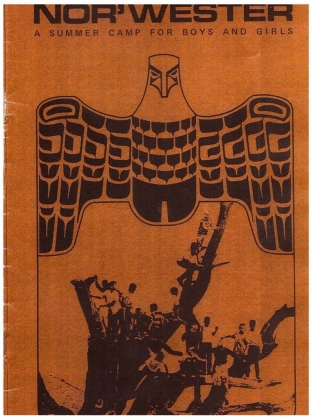 1967 – The Hendersons sold the camp to a group of camp-related families. There was no camp this year, but a staff Potlatch was held in the Bighouse.
1967 – The Hendersons sold the camp to a group of camp-related families. There was no camp this year, but a staff Potlatch was held in the Bighouse.
1968-1980: Sperry Peninsula, Lopez Island – Jack and Jan Helsell
1968 – The Henderson Camps were renamed Camp Nor’wester, and Jack and Jan Helsell were hired as directors. A new Craft Shop was built, greatly expanding this program. Four C-Lark sailboats were purchased, and the 48-foot sloop Courageous was chartered for extended trips. Bill Holm carved Kwigwatsi, a 35 foot Northern-style canoe. Cavemen and Tarzans became Explorers and Rangers; Archers became Mariners. The Troubadour unit was added for the oldest girls. NOFUSS (Nor’wester Flexible Unit Scheduling System) was created by Marty Holm.
1969 – The wooden Willits canoes were retired and replaced with aluminum canoes. The first Boston Whaler was purchased.
1970 – A new dock was installed at Cactus Rock, and a hand-built stone trail along the shoreline was constructed to provide access. A second Girls’ Shower House was built above the Voyageur unit.
1972 – Two new units were added: the Wayfarers (between the Voyageurs and Troubadours) and the Pioneers (between the Rangers and Indians). The Lodge was enlarged and a basketball/volleyball court was built. When Edward Curtis’s 1914 film In the Land of the War Canoes was being restored, a missing scene of a body being thrown off a cliff was filmed on Sea Parrott Bluff.
1973 – Hugh Armstrong, with help from the Troubadours, built the first Adobe Oven using clay from Girls’ Beach. The design was based on an article in Sunset magazine.
1976 – Nor’wester participated in the Lopez Island 4th of July parade for the first time.
1977 – To accommodate a large number of middle age boys, the short-lived Forester unit was created in the woods between the Indian and Islander units.
1979 – When it was learned that Sperry Peninsula was again for sale, a “Save the Camp” campaign was organized to raise funds to purchase the property.
1980 – The camp was purchased by Chuck Curran. This was the last summer the Helsells directed camp.
1981-1989: Sperry Peninsula, Lopez Island – David and Susan Formo
1981 – David and Susan Formo were hired as directors.
1982 – The Cooks’ Cabin was expanded. Unit photos were initiated.
1984 – Staff training was lengthened to a full week, and the first staff training manual was created. Lifejackets were required for all campers and staff while on the water.
1985 – The Weavers, the youngest girls’ unit, was renamed the Archers. The first “Nor’wester Musicale” tape was recorded by Richard Carter and Tim Lamont.
1986 – Staff who had worked at camp for 5 or more years received Staff Jackets. A summer open house on Sperry Peninsula was held to celebrate the camp’s 50th anniversary.
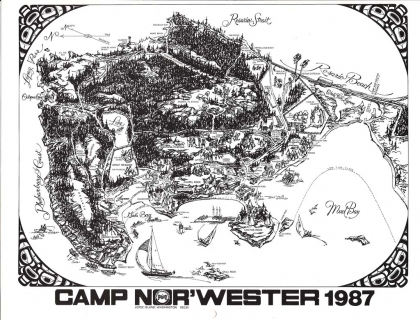 1987 – The infamous “changeover day,” when new campers arrived in Anacortes while the old campers were leaving, was eliminated and replaced with a 48 hour break between sessions. The new calendar format included the unit photos. This was the last year the camp chartered the Courageous.
1987 – The infamous “changeover day,” when new campers arrived in Anacortes while the old campers were leaving, was eliminated and replaced with a 48 hour break between sessions. The new calendar format included the unit photos. This was the last year the camp chartered the Courageous.
1988 – A Ropes and Challenge Course was built.
1989 – This was the last year the Formos directed camp.
1990-1996 – Sperry Peninsula, Lopez Island – Paul Henriksen and Christa Campbell
1990 – Paul Henriksen and Christa Campbell were hired as directors, and the Nor’wester Advisory Board was formed.
1994 – The movie Free Willie II was filmed on the property in the spring. The Outback unit was established for the oldest girls.
1995 – Second session enrollment was 195 campers divided into 6 boys’ units and 7 girls’ units. There were 90 staff members, 7 Lightnings, 6 C-Larks, 13 canoes, 5 rowboats, 2 Boston Whalers, and 28 horses! Nor’wester celebrated its 60th camp season with a reunion in the fall. Not long after, it was announced that Sperry Peninsula was for sale.
1996 – This was the final camp season on Lopez. The sale of the property was finalized in March and Nor’wester left Sperry on September 15th. A group of friends of the camp, not willing to let it close, formed a non-profit corporation in May with the goal of establishing Nor’wester on a new and permanent site.
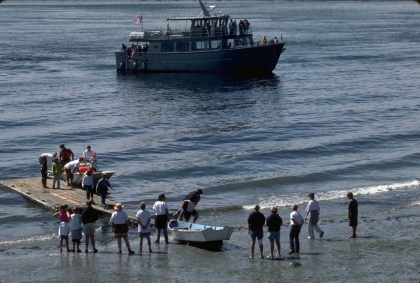 1997-1999 – Camp Was Closed – Paul Henriksen and Christa Campbell
1997-1999 – Camp Was Closed – Paul Henriksen and Christa Campbell
1997 – Efforts were focused on securing a new site. Over one hundred locations were assessed. No suitable site was found in the San Juan Islands so the decision was made to acquire 135 acres on Cortes Island in British Columbia.
1998 – When the 132 acre Nell Robinson Ranch on Johns Island in the San Juans became available, the Nor’wester Board of Directors shifted its efforts from Cortes Island and concentrated on acquiring the Johns Island property. A deal was reached in August and applications for the necessary permits were submitted soon after.
1999 – A very favorable ruling by the San Juan County Hearing Examiner resulted in the approval of Nor’wester’s Conditional Use and Shoreline Permits. The office, health center, cooks’ quarters and kitchen were barged from Lopez to Johns Island. The old kitchen was used for storage for a number of years and later dismantled.
2000-2011 – Johns Island – Paul Henriksen and Christa Campbell
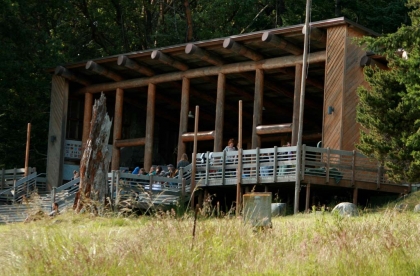 2000 – Camp reopened on Johns Island with a reduced program for the initial season. There was a 1-week session for 9-12 year olds, a 3-week session for 13-16 year olds, and a 4-week leadership training session, named the Peregrines, for 17-18 year olds. The Indian unit was renamed the Foresters. Total enrollment for the summer was 127 campers. Construction of the shower houses and water system was completed prior to the start of camp, but the office, health center, craft shop, and Lodge were housed in army tents, and the kitchen was in a trailer. Construction of the new Lodge continued throughout the summer. Bill Holm, with family and friends, presented a sampling of traditional Northwest Coast Native Dances. A formal dedication of the property was held on August 9th. More than fifty people attended a family weekend for alumni.
2000 – Camp reopened on Johns Island with a reduced program for the initial season. There was a 1-week session for 9-12 year olds, a 3-week session for 13-16 year olds, and a 4-week leadership training session, named the Peregrines, for 17-18 year olds. The Indian unit was renamed the Foresters. Total enrollment for the summer was 127 campers. Construction of the shower houses and water system was completed prior to the start of camp, but the office, health center, craft shop, and Lodge were housed in army tents, and the kitchen was in a trailer. Construction of the new Lodge continued throughout the summer. Bill Holm, with family and friends, presented a sampling of traditional Northwest Coast Native Dances. A formal dedication of the property was held on August 9th. More than fifty people attended a family weekend for alumni.
2001 – A permanent dock was installed midsummer at Cottonwood Cove. 12 kayaks were added to the waterfront program. The capture-the-flag course was laid out. The Sun Pole, the only monumental carving to make the trip from Lopez to Johns Island, was raised at its new site. A welcome pole, carved by Bill Holm, was erected below the Lodge and nicknamed “Long John.” Eagle and Raven poles, carved by Calvin Hunt, were raised at Cottonwood Cove. The Eagle represents Camp Nor’wester, and the Raven is the crest of the Hunt family. Calvin and members of his family from Vancouver Island revived the tradition of participating in our Potlatch celebration, performing family dances and songs. Total enrollment for the summer was 164 campers.
2002 – A shorter, 12-day session for Explorers and Archers was implemented. Cedar logs for the house posts of the new Bighouse were donated by Jack and Jan Helsell, and carving began on Lopez. The Ropes course was built. Tent platforms were constructed in the Explorer unit. This was the first year of Explore Nor’wester, an introductory, 4-day session for new families and alumni with younger children. Calvin Hunt carved a log drum for the new Bighouse.
2003 – Tent platforms were built in the Archer unit. Permits for construction of the Bighouse were approved by the County. Site work continued throughout the summer to prepare the area. Carving continued on the four house posts. Calvin Hunt carved a box drum for the Bighouse. Bill and Marty Holm’s 50th wedding anniversary was celebrated.
2004 – Construction on the Bighouse continued. The corner posts were erected and the cross beams put in place. Calvin Hunt gave the Bighouse its name: Nawalagwatsi, “Receptacle of Magic.” Two fiberglass Nuuchah-nulth style canoes designed by Calvin Hunt were donated by the Holm and Charnley families. A 24′ yurt was erected to provide staff with a much-needed R&R site on property. A CD of camp songs, performed by a group of staff and campers, was produced.
2005 – The Camp’s 70th anniversary was celebrated in May at Pickering Barn in Issaquah. The Bighouse was completed and dedicated. Calvin Hunt gifted Camp a beautiful carved oversized spoon. The Maintenance building was built, and the soccer field was leveled. Camp broke even for the first time since relocation, covering all operational expenses. Accreditation was received from the American Camp Association for the first time since leaving Sperry Peninsula. The “Get the Point” Campaign was initiated to purchase the 37-acre Point Property which was being leased from a camp alum.
2006 – The Lightning sailboats were overhauled, receiving new masts, riggings, and fittings. With enrollment surpassing 300 for the first time since moving to Johns Island, revenue from enrollment covered not only operational expenses, but also the mortgage payments on the 100 acres purchased in 1998. Calvin Hunt carved a Sisiutl arch to span the stairs at South Beach. The Board of Directors began a Strategic Planning process.
2007 – The new Craft Shop was completed. A Laser and six Picos were added to the sailing fleet.
2009 – The “Get the Point” campaign successfully concluded with the purchase of the 37-acre Point Property. This gave Camp ownership of its entire 132-acre site. Calvin Hunt carved bear and raven staffs for the teams at Potlatch Games and gifted them to Camp.
2010 – A new adobe oven was built from cinder blocks and finished with stones from the island. The Nor’wester eagle sprouted feet and a tail for the first time. The first annual Camp Nor’wester Online Auction was held. After Paul and Christa announced their plan to retire, the Board began the search for a new Executive Director.
2011 – A falling tree near the Maintenance Building crushed Kwigwatsi beyond repair. Bill Holm and friends began immediate planning for the carving of a new canoe. The first composting toilet was completed behind the Lodge. The barn was rebuilt. Calvin Hunt gifted a “Chief’s Settee” for use in the Bighouse.
2012-2023 – Johns Island – Sheila Tallmon and Jill Steigerwald
2012 – After an extensive search, the Board named Sheila Tallmon as Executive Director beginning in January. She had worked for many years at the Cheley camps in Colorado. Sheila hired Assistant Director Jill Steigerwald, a veteran of three years at Nor’wester. Carving of the new 35-foot canoe began in the summer under the direction of Bill Holm and lead carver, Steve Brown. The VSU (garage) was constructed.
2013 – Shaun Peterson painted the Wolves on the south wall of the Craft Shop. Raised beds were added at the garden. An extensive renovation effort was started on the Health Center and continued through the following year. The building enlarged, put on new foundations, and upgraded to current building codes.
2014 – Four new Lightning sailboats were purchased to replace the camp’s aging fleet and saw their first voyage during First Session Big Trips. Shaun Peterson painted the welcome figure on the north side of the Craft Shop. The Berhow family created the Madrona Theater.
2015 – Camp was fully enrolled (340 campers) for the first time since relocating to Johns Island. The Camp acquired a Gator for Camp Operations. A new platform tent structure was built for visitor housing and permanent cubbies were installed in each shower house. Construction began on a new deck structure on the west side of the Lodge that will house a donor recognition display. A storage shed for waterfront equipment was built near Mission Point. The Camp’s 80-Year anniversary was celebrated with special events: A Seattle-area gathering in April and a celebration on Johns Island over Labor Day weekend. Over 300 alumni join in the celebrations.
2017 – A 28′ climbing wall was donated the previous fall and construction of the new program area was completed in time for summer. The new office construction began and the building was used unfinished for the first time in the summer season!
2018 – The office was officially completed and all spaces were used to their fullest extent for the summer season! Also in the spring, the Board approved the payoff of the last mortgage, which means the camp now owns all the property outright and has no outstanding debt. This should ensure that Camp Nor’wester has a long and bright future. Steve Brown completed Gwawina’dzi (Raven’s Nest), a 33′ wooden dugout canoe, on property and took it to the water for sea trials on Visitors’ Weekend of Second Session. Additionally, a 32′ totem pole, donated and carved by Calvin Hunt, was lifted and set in front of the lodge, honoring the Hunt family’s relationship with the Holms and Camp over the years.
2019 – 20 summers of Camp on Johns Island! Enrollment reached full capacity for the fifth year in a row. Working groups for a new Boathouse/Storage Facility and Trader Horn were formed.
2020 – Celebrating 85 Years! Nor’wester’s Virtual Engagement Program took the place of in-person camp sessions on Johns Island due to mandated closure in response to the COVID-19 pandemic. A Virtual reunion event was held in August to celebrate camp’s 85th year.
2021 – Successful in-person camp sessions resumed on Johns Island with preventative measures in place to reduce the risk of COVID-19 transmission, with full enrollment. The Boathouse facility was used for its first season!
2022 – Canoe families from the All Nations Paddles Up journey stopped over on WTAEMEN/Johns Island for a night during their paddle to Orcas during Changeover, starting a new connection between Camp and two elders and educators, Ron Snyder (Haida) and Cathy Taggett (Tlingit). In the fall, Sheila announced that 2023 would be her last summer with Nor’wester. Construction began on the Henderson Commons project.
2023 – A search process began for Camp’s new Executive Director. A Language Immersion Program for WSANEC School and Whatcom Intergenerational High School students was held on property in the spring. Ron and Cathy spent a week at Camp as educators-in-residence during First Session, and the Holm and Hunt families visited at the end of Second Session for the first time since 2019. Sheila had a very memorable final summer, full of celebration and appreciation. After the summer, the Board announced that Meaghan Baumgartner would start as Nor’wester’s Executive Director in October.
2024-Present: Meaghan Baumgartner and Jill Steigerwald
2024 – 25 years of Nor’wester on Johns Island!!! Stay tuned for updates from the summer and Meaghan’s first year with Nor’wester.
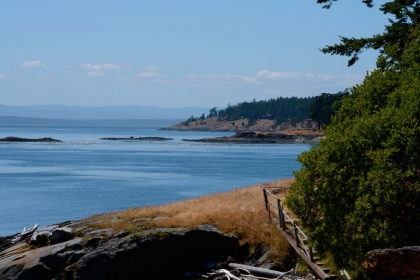
Our history as an organization is full of moments of pride, challenge, growth and reinvention.
What has resurfaced decade after decade is the strong resiliency demonstrated by Nor’wester’s leadership and alumni base.
We are grateful for everything that has happened in the past so that the Nor’wester mission could continue. Generations of campers will be able to experience the views from the Lodge at camp for many, many years to come.

